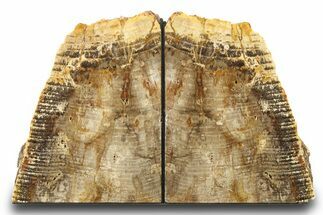7" Petrified Wood (Oak) Bookends - Oregon
This is a beautiful pair of bookends made from petrified wood found near Stinking Water Creek, Oregon. The wood is Eocene aged (50 million years) and identified as a species of oak.
Each bookend slightly varies in size, with one measuring 7" tall, 6.5" wide and 1.7" thick, while the other is 6.7" tall, 6.3" wide and 1.9" thick.
The display surface has been highly polished, showing off the inner grains and growth rings beautifully. The work is done by one of the best petrified wood polishers around, so the quality is second to none. The contact surfaces have been lined with felt to prevent scratching.
Each bookend slightly varies in size, with one measuring 7" tall, 6.5" wide and 1.7" thick, while the other is 6.7" tall, 6.3" wide and 1.9" thick.
The display surface has been highly polished, showing off the inner grains and growth rings beautifully. The work is done by one of the best petrified wood polishers around, so the quality is second to none. The contact surfaces have been lined with felt to prevent scratching.
What Is Petrified Wood
Petrified wood is the name given to wood that has been turned into stone (fossilized) through the process of permineralization. In this process, all of the organic matter becomes replaced by minerals, while much of the original structure, such as tree rings, is retained. For this to happen, the wood needs to be buried in an environment low in oxygen to prevent decomposition and with flowing, mineral-laden water, so minerals may replace structures. The coloration is caused by various minerals that present in that water during fossilization. For example, red colors are due to iron compounds, greens due to copper, and so on.
Petrified wood is the name given to wood that has been turned into stone (fossilized) through the process of permineralization. In this process, all of the organic matter becomes replaced by minerals, while much of the original structure, such as tree rings, is retained. For this to happen, the wood needs to be buried in an environment low in oxygen to prevent decomposition and with flowing, mineral-laden water, so minerals may replace structures. The coloration is caused by various minerals that present in that water during fossilization. For example, red colors are due to iron compounds, greens due to copper, and so on.
$175
SPECIES
Oak
AGE
LOCATION
Stinking Water Creek, Oregon
SIZE
7 x 6.5 x 1.7"
CATEGORY
SUB CATEGORY
ITEM
#307179
We guarantee the authenticity of all of our specimens.
 Reviews
Reviews












